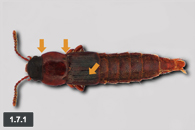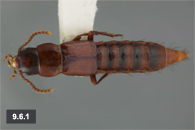
| Olisthaerinae C.G. Thomson: Olisthaerus Dejean 1833 |
||||||||
 |
||||||||
| Figure 1.7.1 Olisthaerus substriatus Gyllenhal, dorsal habitus. 9.6.1 O. megacephalus Zetterstedt, dorsal habitus. 9.6.2 O. substriatus, from under bark in a relict boreal forest (Jefferson's Notch, NH). 9.6.3 O. substriatus from under pine bark. | ||||||||
|
||||||||
 |
||||||||
The genus Olisthaerus can be recognized by an elongate and parallel body, a dark head, red pronotum and abdomen, a parallel-sided pronotum, and the longitudinal striae of the elytron (Fig. 1.7.1). The genus Siagonium Kirby and Spence is loosely similar in appearance but is easily separated by the rows of coarse punctures on the elytra and the presence of cephalic horns in males. |
||||||||
 |
||||||||
Two rare Holarctic species occur in ECAS: O. megacephalus (Zetterstedt) and O. substriatus (Gyllenhal). Olisthaerus megacephalus differs from O. substriatus by the wider head and smaller, flat eyes (Fig. 9.6.1). They are found under the bark of dead conifers (Newton et al. 2000) within the boreal forest ecozone (both species) or in relict boreal forests found on mountains in New York and New Hampshire (O. substriatus only) (Fig. 9.6.2). In boreal forest surveys, O. substriatus (Paquin and Duperre 2001) and O. megacephalus (Hammond et al. 2004) were captured exclusively within ‘old’ (>100 years old) or old growth forests. The feeding habits of Olisthaerus are unknown. Olisthaerus megacephalus and the subfamily Olisthaerinae are newly recorded for the province of Newfoundland and Labrador. NL: Labrador, Nain, 56.5 -61 75, 2-VII-1983, R. Sexton, 1 (DEBU). |
||||||||




